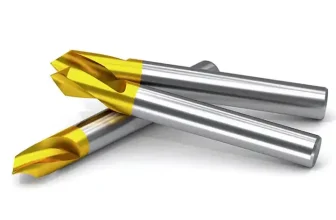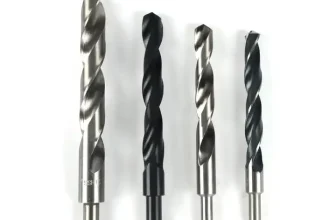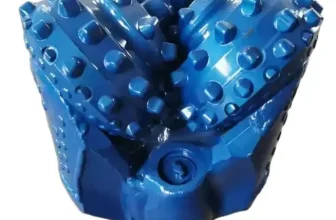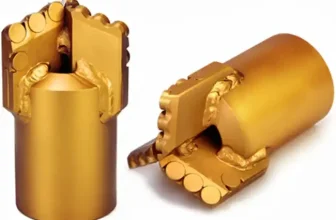Drilling porcelain tile is a very specific type of drilling.
It is important to use the best drill bit for porcelain tile to make sure the job goes smoothly and quickly.
Not using the proper bit for porcelain tile can easily damage the tile itself during the drilling process.
Laying tile is an expensive and time consuming process, so you definitely want to avoid damaging it.
Porcelain is a Hard Material
If you have never drilled through porcelain tile before you might think it is easy, especially if you have experience drilling other materials such as metal.
After all, porcelain is a lot easier to break versus a piece of metal right?
While that may be true, porcelain is brittle because it is an extremely hard material.
At first this might not seem to make any sense, but if you think about a more common material like glass that is also very hard but brittle, porcelain is similar but much harder.
This might surprise you, but porcelain is actually much harder than even a hardened steel file.
Diamonds are Your Best Friend
Because of this level of hardness, the best drill bits for porcelain tile are actually diamond tipped bits.
You might be temped to use a masonry bit to drill porcelain tile, but while these are okay for ceramic tile porcelain tile is harder than ceramic.
When you hear the word diamonds you may be thinking, “That sounds expensive!”
Fortunately, diamond tipped drill bits are much less expensive that diamond jewelry!
Technique Matters
Once you have the best drill bit for porcelain tile that is only the first step in the process of drilling a hole.
There is also some technique involved to make sure you do not damage your expensive porcelain tile in the process of drilling it.
Even if you have the best drill bit for drilling porcelain tile, making mistakes in the drilling process can still cause major problems.
Ok, so you have the bit you need (diamond tipped is the best).
Make Sure the Tile is Stable
The next step is to make sure the porcelain tile is secure.
If the tile is already installed then this will not be a problem, but if you are drilling a loose tile then make sure you place the tile on a clean, non-skid surface.
You do not want the tile moving around while you are in the process of drilling it.
Something else to keep in mind, it is a good idea for the surface placed under the tile to be something you do not mind drilling into.
If you are drilling a loose tile on something that is important then you should place the tile on a piece of wood, rubber, or some other piece of material you do not mind being drilling into and damaged.
Beware of Edges and Holes too Close
Something you should be aware of is that since porcelain tile is brittle it is easily cracked when drilling holes too close to the edge of a tile or drilling holes close together.
If at all possible, you should avoid these types of holes unless it is absolutely necessary.
If you must drill holes very close together or near the edge of a porcelain tile you should be drill slowly and with minimal pressure.
Just take your time.
Use Tape
It is a good idea to place some tape over the area you plan to drill.
This will help prevent the tile material from chipping off around the edge of the hole.
It will basically make sure the hole edge is smooth and can help prevent cracking of the tile around the hole.
Mark Your Holes
Now that you have made sure the porcelain tile you are drilling is stable you should make a mark on the tile where you intend to drill your holes.
This is good place to practice the old adage of, “Measure twice, cut once!”
Once you measure and mark your holes measure again to double check everything is where you want it.
Drilling porcelain tile is a time consuming process with mistakes being potentially expensive, so it makes sense to make sure you are drilling exactly where you intend.
A Drill Guide can be Helpful
There are drill guides available that can help you make sure you are holding your drill at the proper angle.
This is always important no matter what type of material you are drilling, but it is even more important when drilling porcelain tile.
There are a wide variety of these drill guides available.
A drill guide is actually a great too to have in your tool box for all types of drilling.
You should definitely consider purchasing one if you plan to do very much drilling at all.
If you do not want to purchase a drill guide you can make your own by drilling a hole in a piece of wood or even metal.
The hole in the guide should be the same size at the one you plan to drill in the porcelain tile.
Be Patient
If you are used to drilling other materials like wood, aluminum, or standard steels then you will be used to a faster drilling process compared to drilling porcelain tile.
You can expect each hole drilled to take a least a few minutes, maybe more for larger holes.
You should apply firm pressure, but do not be too forceful.
Using too little pressure is better than applying too much pressure when drilling porcelain tile.
Just keep in mind that you do not want to risk damaging the tile or overheating the drill bit.
If the drill bit gets overheated it will reduce its effectiveness.
This will cause the bit to take longer when drilling future holes and also decrease the quality of the holes it drills.
Keep Things Cool
Drill bit overheating is the enemy of of a bit’s performance and useful life.
It is a good idea to have some water handy to apply to the drill bit when drilling porcelain to help keep the bit cool.
This is something that is easy to do, but it provides a great benefit to the performance and longevity of your drill bit.
Final Thoughts
We hope you use these tips the next time you are drilling porcelain tile, and that you find them useful.
Just remember to use the best bit for porcelain tile and follow these tips.
You will be more likely to get the results you will be happy with!







